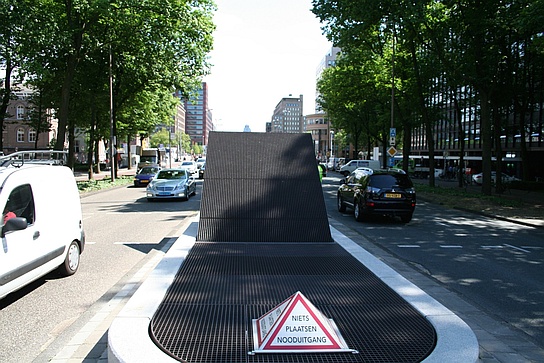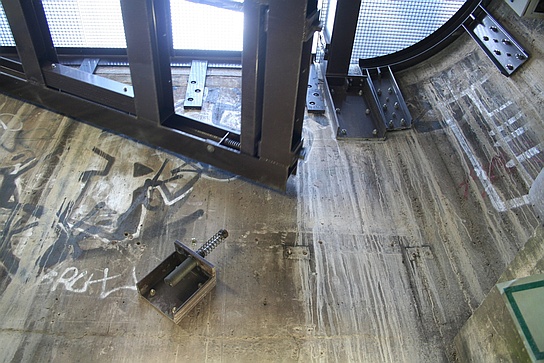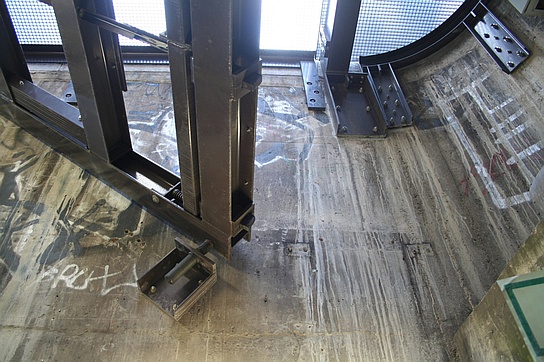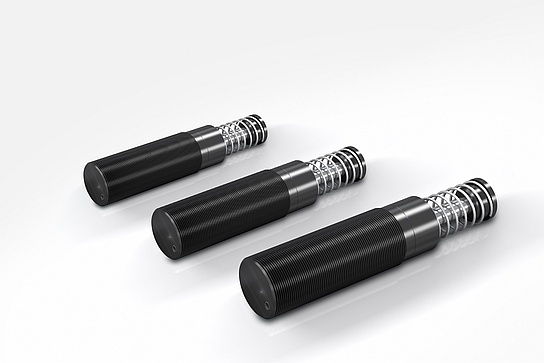MAGNUM shock absorbers reliably dampen 5 ton safety barrier
 Download ACE Press Release 10/23/2018
Download ACE Press Release 10/23/2018
Industrial shock absorbers make escape routes even safer
In case of fire there is an acute danger to life in subway tunnels. In addition to prophylactic fire protection, the functional safety of emergency exits has a life saving significance. At the Weesperplein station of the Amsterdam Metro, a sophisticated security system ensures that people reach the streets above the tunnel in a minimum of time. A former nuclear protection bunker plays just as much of a role as industrial shock absorbers made by ACE.
Awareness of potential danger spots in public spaces has risen steadily throughout Europe in recent years and decades, which is reflected in corresponding security concepts. The greater the danger, the greater the demands. If city officials also have to include potential masses of people as in football stadiums or subway stations in their plans to avoid disaster, the requirements will increase yet again. At the Weesperplein metro station this meant that the safety exits were completely rebuilt. On behalf of the Gemeente vervoerbedrijf (GVB), a wholly owned subsidiary of the city of Amsterdam, which also operates the Metro built in 1977, J. P. van Eesteren B.V. was the enterprise responsible. This company is one of the largest in the Dutch construction industry.
The network of Amsterdam's Metro extends over a length of 42.5 kilometers, of which four kilometers run underground. The station Weesperplein plays a special role due to the existing nuclear bunker, as the planners could use a large network of escape routes that run through it. One of these protective paths seemed particularly predestined in allowing the public to reach the surface in the quickest possible way. To ensure that as many people as possible get there safely in an emergency, it is very wide and ends at an exit that lies on a traffic island on a busy street. A traffic sign warns passers-by in order to keep this exit free of obstacles such as heavy goods or parked cars at all times, otherwise it could be mistaken for a ventilation shaft just protected by a large barrier with a steel grid construction. With a mass of almost 5 tons and located horizontally over the exit gate, this barrier is of considerable proportions.
Industrial shock absorbers provided by ACE master all challenges
Such a mass cannot to be operated manually, and certainly not in an emergency. Instead, the large barrier has a non-central pivot point and opens mechanically as soon as it is unlocked. The immediate movements create a lot of energy which have to be slowed down at the end position, so that no one is injured in the case of an emergency exit or a fire drill and no costly damage to the overall construction happens in the process. This is where ACE Stoßdämpfer GmbH, well-known through its own distribution network in the Netherlands, comes into play, albeit via a detour. For at first the city of Amsterdam tried a solution supplied by a competitor. However, the first dampers were too small for the task. It later turned out that the original calculations by the competitor had been non sufficient. In a test, this resulted in one of the dampers being completely destroyed on the first impact. Even though there are rarely fires in Dutch subways, the result was unsatisfactory.
To spare their customers further failures in the shock absorber department, the engineers of J. P. van Eesteren B.V. contacted the ACE representatives for the Netherlands, Ralf Küppers and Han Titulaer. Since there was no exact information about the speed of the impact, the two got in touch with the technicians at ACE Stoßdämpfer GmbH in Langenfeld, Germany. There, product manager Christian Junghans and technical consultant Stefan Bühler took care of the product layout for this case. Both determined possible impact speeds through a series of 3D simulations. As a result, self-compensating MC64150EUM industrial shock absorbers were chosen to reliably decelerate the masses of the heavy barrier and to keep it safely in check after having been opened. In this specific case, 5,650 Nm per stroke and per machine element can be absorbed to reduce the energy of the masses almost immediately, and a maximum of 63,700 kg of effective mass can be successfully handled. Also, the impact speed of about 1.8 meters per second and the unusual impact angle of the exit barrier, which can be seen in the pictures, did not pose a problem for the ACE solution.
As industrial shock absorbers, which have been part of the MAGNUM family for more than a decade, the new hydraulic dampers, like all ACE products, were easily integrated into the existing design thanks to a variety of accessories and connectors. For J. P. van Eesteren B.V. an emergency exit safety system has been put into place that can persist permanently. This is owing to the fact that MAGNUM dampers are extremely durable and, therefore, probably suitable for more load changes than the operators ever have to put them through in fire drills or during real life threatening emergencies. Seen from this point of view and above all in combination with the partnership, the Dutch clients are fully satisfied with their new hydraulic helpers and are looking forward to the future for the Metro Amsterdam and all passengers.
Emergency exit of Metro Amsterdam at the subway station Weesperplein: Seen from above almost a normal traffic island with a horizontally installed safety barrier weighing almost 5 tons:
To open and close the barrier in case of an emergency two ACE industrial shock absorbers, type MC64150EUM, were installed:
Neither the impact speed of about 1.8 meters per second nor the unusual impact angle of the pivoting exit barrier pose problems for ACE’s industrial shock absorbers:
Industrial shock absorbers from ACE’s MAGNUM family, which has been successful and proven for many years, are available for tasks like this. They come as self-compensating or adjustable machine elements with thread sizes M33, M45 and M64 and strokes from 25 to 150 mm:
